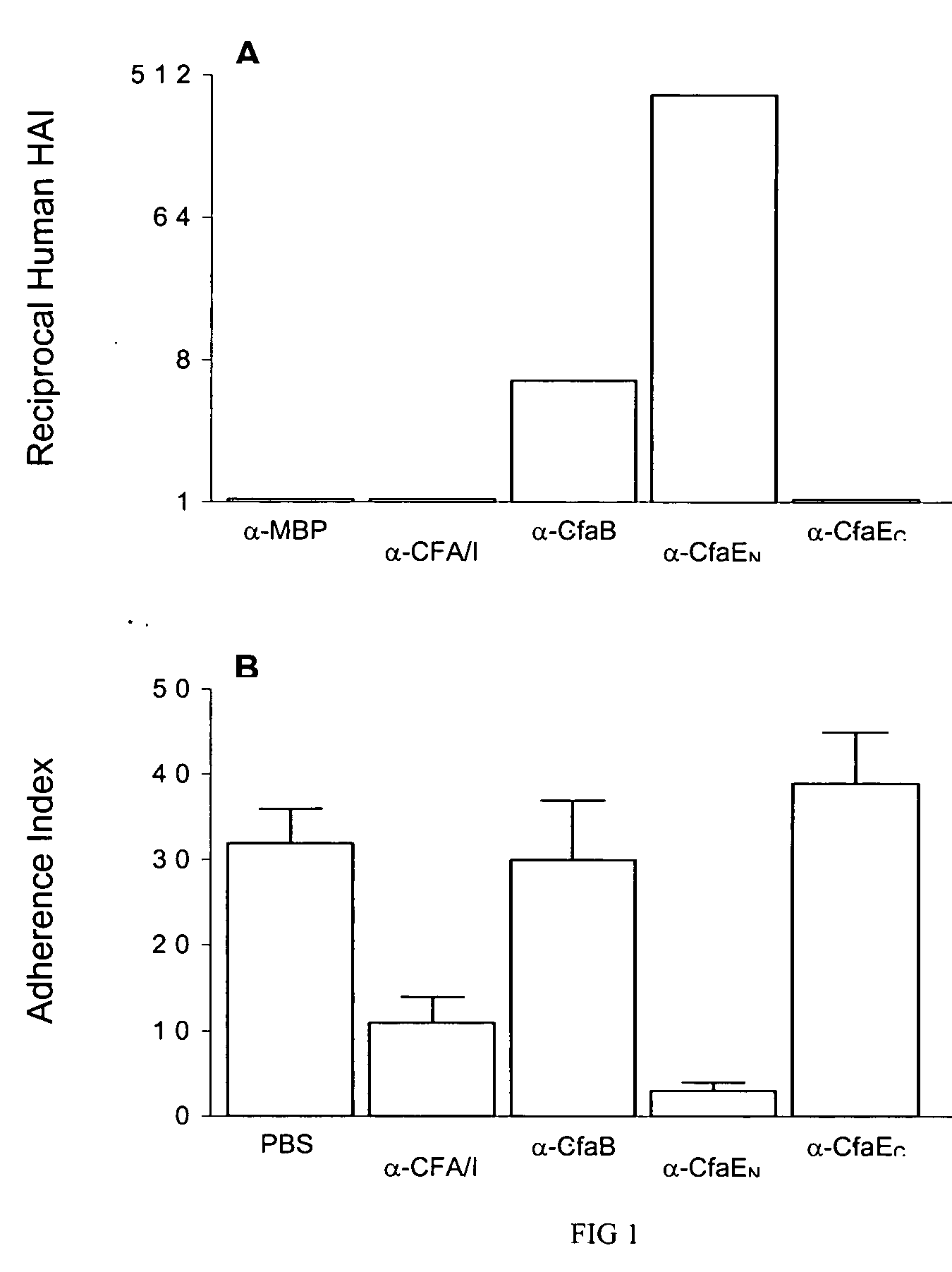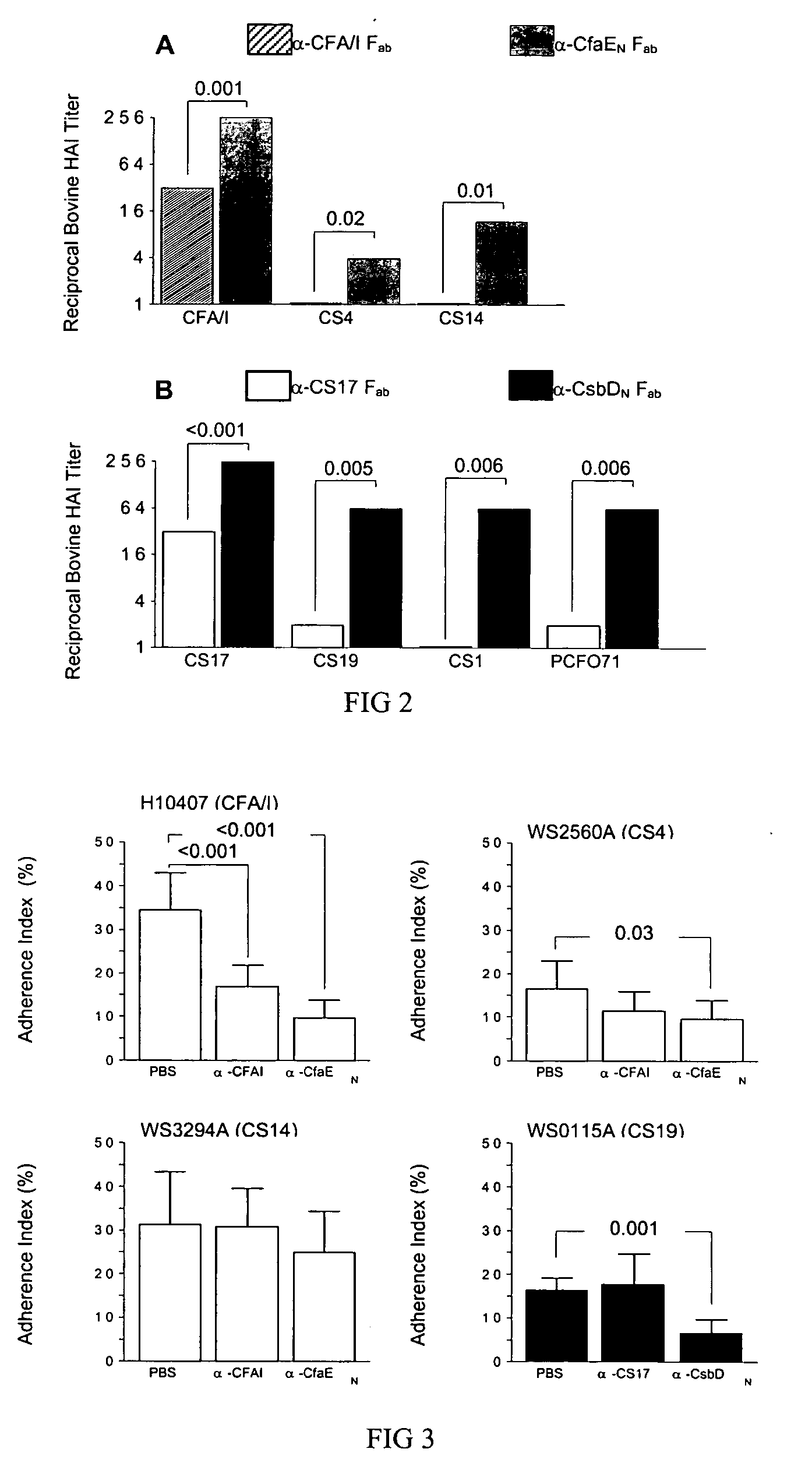Adhesin as immunogen against enterotoxigenic Escherichia coli
a technology of enterotoxigenic escherichia coli and adhesion protein, which is applied in the field of adhesion protein as immunogen against enterotoxigenic escherichia coli, can solve the problems of inadequate efficacy of vaccines against many diarrheagenic bacteria such as enterotoxigenic i>escherichia coli /i>, and medical infrastructure, and achieve the effect of inhibiting the adhesion of fimbria
- Summary
- Abstract
- Description
- Claims
- Application Information
AI Technical Summary
Benefits of technology
Problems solved by technology
Method used
Image
Examples
example 1
Adhesin is the Most Important Vaccine-Related Enterotoxigenic Escherchia coli Bacterial Component
Class 5 Escherchia Coli Fimbriae Binding
[0044] CFA / I is the archetype of a familiy of ETEC fimbriae sharing genetic and biochemical features (5, 4, 6, 7). The gene operons are composed of a periplasmic chaperone, major fimbrial subunit, outer membrane usher protein and a minor fimbrial subunit. Based on the major subunit sequence, CFA / I and related fimbriae have been grouped together as class 5 fimbriae (16, 21). Studies have confirmed that there is a confirmed functional distinction between class 5 major and minor fimbrial subunits and that the minor subunits serve as adhesins. Therefore, the minor subunits are the most important component of fimbriae for vaccine construction.
[0045] Type strains that individually express each of the Class 5 ETEC fimbriae were characterized with respect to erythrocyte adherence by mannose-resistant hemagglutination (MRHA) with type A human, bovine, a...
example 2
Conformationally Stable Donor-Strand Complemented Class 5 Adhesive Fimbrae-Adhesin Immungenic Construct
[0061] Computational analyses of the CFA / I structural subunits suggests that donor strand complementation governs chaperone-subunit and subunit-subunit interaction. Therefore, we constructed a conformationally-stable construct wherein an amino-terminal donor β-strand of CfaB provides an in cis carboxy-terminal extension of CfaE to confer conformational stability and protease resistance to this molecule forming a soluble monomer capable of binding human erythrocytes.
[0062] We generated a multiple alignment of the amino acid sequences of the eight homologs of the major and minor subunits of Class 5 ETEC fimbriae to identify common structural motifs. Secondary structure prediction algorithms indicated that both subunits form an amphipathic structure rich in β-strands distributed along their length. Twenty six percent of the consensus minor subunit sequence is predicted to fold into ...
example 3
Method for the Induction of Immunity to Conformationally Stable Class 5 Adhesin Construct
[0077] The adhesins, located on the distal tip of fimbriae of certain E. coli are the most important component for the induction of diarrheagenic E. coli bacterial immunity. However, fimbrial adhesins are inherently unstable and subject to degradation when devoid of their non-covalent linkage to major subunits fimbrial components. Therefore, improvements in conferring of protease resistance and conformational stability is important for production of maximually effective induction of B-cell activity capable of conferring anti-adhesive immunity against E. coli, including enterotoxigenic E. coli.
[0078] An aspect of this invention is the construction of stable polypeptide construct, as shown in Example 2. As taught in Example 1, protection against pathology caused by E. coli can be mediated by inhibition of colonization of bacteria by sterically hindering adhesion of fimbriae, and therefore bacter...
PUM
| Property | Measurement | Unit |
|---|---|---|
| Time | aaaaa | aaaaa |
| Mass | aaaaa | aaaaa |
| Mass | aaaaa | aaaaa |
Abstract
Description
Claims
Application Information
 Login to View More
Login to View More - R&D
- Intellectual Property
- Life Sciences
- Materials
- Tech Scout
- Unparalleled Data Quality
- Higher Quality Content
- 60% Fewer Hallucinations
Browse by: Latest US Patents, China's latest patents, Technical Efficacy Thesaurus, Application Domain, Technology Topic, Popular Technical Reports.
© 2025 PatSnap. All rights reserved.Legal|Privacy policy|Modern Slavery Act Transparency Statement|Sitemap|About US| Contact US: help@patsnap.com



